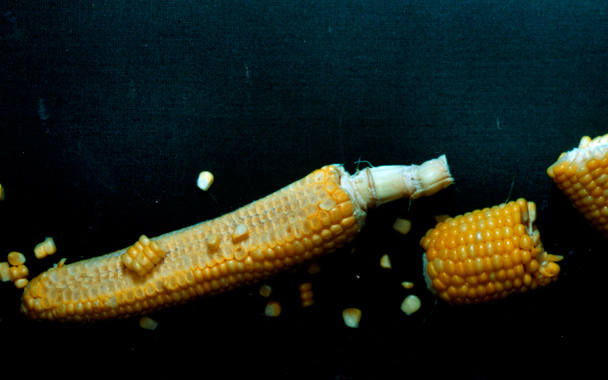A lot of cheese and animal producers at the Greenmarket have raised their prices a little recently so they don’t go broke as the cost of feed grain goes through the roof. Paul from Violet Hill was looking on the bright side. “Maybe corn will get so expensive I can afford to feed my animals oats and flax and wheat,” he said. “Corn is sort of a slutty grain, isn’t it?”
Corn has a bad rap these days, and it’s easy to understand why: It’s used as a sweetener in terrifying number of processed foods, and it’s usually grown in the most industrial manner imaginable. But one of the best things about winter in our house is a big batch of creamy polenta, rich with cheese and milk and topped with a grilled sausage and some sautéed greens. I like to make enough extra that I can form the leftovers into cakes, grill or sauté those babies, and bury them under a spicy ragout.
Last week, though, I made my hominy whole, in the form of a big pot of pozole.
Dent corn (the kind used to make grits and the like, as opposed to sweet corn) has a thick, indigestible hull which the Mayans and Aztecs learned to remove by soaking in a strongly alkaline solution of water and lime or ashes. That process, called nixtamalization (which you should really say out loud), adds a particular citric-sour note to the corn flour that’s used in good corn tortillas, tamales, and arepas. Pozole is corn that’s been nixtamalized but left whole. You can buy it in big cans in Mexican markets, but the last time I was in San Francisco the excellent people at Rancho Gordo were selling packets of it dried, which I snapped up and brought home. Heirloom pozole—who could pass that up?
Pozole (the dish) is usually a big stew with meat, chiles, and those corn kernels cooked until they bloom and just start to fall apart. One style I like a lot calls for pumpkin seeds and tomatillos, but the tomatillos in particular are hard to find in my neighborhood. So I went with a red version by braising some pork shortribs, shredding the meat, and reserving the stock. I par-cooked the pozole with an onion until it was nearly done and let it cool in its cooking liquid. Next, I sweated some onion and garlic in a big soup pot with a lot of Mexican oregano, some toasted and reconstituted ancho chiles, and some Caribbean peppers I had in the freezer from last summer. Then I poured in the ribs, pork stock, and hominy, and let everything bubble away gently for another hour. Big bowls served with cilantro and avocado didn’t quite fool us into believing we were in Mexico, but neither did we still feel completely stuck at the tail end of winter.




 Pinterest
Pinterest


